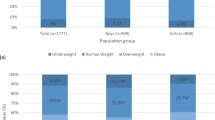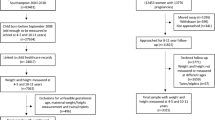Abstract
Background:
Infant weight and weight gain are positively associated with later obesity, but whether there is a particular critical time during infancy remains uncertain.
Objective:
The aim was to investigate when and how weight and weight gain during infancy become associated with childhood obesity.
Methods:
In a cohort representing 28 340 children born from 1959–67 and measured in Copenhagen schools, 962 obese children (2007 World Health Organization criteria), were compared with a 5% randomly selected sub-cohort of 1417 children. Information on weight at birth, 2 weeks, 1, 2, 3, 4, 6 and 9 months was retrieved from health visitors’ records. Odds ratios and 95% confidence intervals (CI) for childhood obesity by tertiles of weight at each age and by change in tertiles of weight between two consecutive measurements were estimated using multivariate logistic regression with adjustment for indicators of socioeconomic status, preterm birth, and breastfeeding.
Results:
Compared with children in the middle weight-tertile, children with a weight in the upper tertile had a 1.36-fold (CI, 1.10–1.69) to 1.72-fold (CI, 1.36–2.18) higher risk of childhood obesity from birth through 9 months, whereas children in the lower weight-tertile had almost half the risk of obesity from 2 through 9 months. The risk of childhood obesity associated with change in weight-tertile in each interval was stable at ∼1.5-fold per weight-tertile increase throughout infancy.
Conclusions:
Infant weight and weight gain are associated with obesity in childhood already during the first months of life. Determinants of weight gain shortly after birth may be a suitable target for prevention of obesity.
This is a preview of subscription content, access via your institution
Access options
Subscribe to this journal
Receive 12 print issues and online access
$259.00 per year
only $21.58 per issue
Buy this article
- Purchase on Springer Link
- Instant access to full article PDF
Prices may be subject to local taxes which are calculated during checkout



Similar content being viewed by others
References
Moss BG, Yeaton WH . Young children’s weight trajectories and associated risk factors: results from the early childhood longitudinal study-birth cohort. Am J Health Promot 2011; 25: 190–198.
Reilly JJ, Kelly J . Long-term impact of overweight and obesity in childhood and adolescence on morbidity and premature mortality in adulthood: systematic review. Int J Obes (Lond) 2011; 35: 891–898.
Gillman MW . The first months of life: a critical period for development of obesity. Am J Clin Nutr 2008; 87: 1587–1589.
Hesketh KD, Campbell KJ . Interventions to prevent obesity in 0-5 year olds: an updated systematic review of the literature. Obesity (Silver Spring) 2010; 18: S27–S35.
Baird J, Fisher D, Lucas P, Kleijnen J, Roberts H, Law C . Being big or growing fast: systematic review of size and growth in infancy and later obesity. BMJ 2005; 331: 929.
Druet C, Stettler N, Sharp S, Simmons RK, Cooper C, Davey Smith G et al. Prediction of childhood obesity by infancy weight gain: an individual-level meta-analysis. Paediatr Perinat Epidemiol 2012; 26: 19–26.
Monteiro PO, Victora CG . Rapid growth in infancy and childhood and obesity in later life—a systematic review. Obes Rev 2005; 6: 143–154.
Ong KK, Loos RJ . Rapid infancy weight gain and subsequent obesity: systematic reviews and hopeful suggestions. Acta Paediatr 2006; 95: 904–908.
Stocks T, Renders CM, Bulk-Bunschoten AM, Hirasing RA, van BS, Seidell JC . Body size and growth in 0- to 4-year-old children and the relation to body size in primary school age. Obes Rev 2011; 12: 637–652.
Stettler N, Stallings VA, Troxel AB, Zhao J, Schinnar R, Nelson SE et al. Weight gain in the first week of life and overweight in adulthood: a cohort study of European American subjects fed infant formula. Circulation 2005; 111: 1897–1903.
Singhal A . Does weight gain in infancy influence the later risk of obesity? J Pediatr Gastroenterol Nutr 2010; 51: S119–S120.
Paul IM, Bartok CJ, Downs DS, Stifter CA, Ventura AK, Birch LL . Opportunities for the primary prevention of obesity during infancy. Adv Pediatr 2009; 56: 107–133.
Baker JL, Olsen LW, Andersen I, Pearson S, Hansen B, Sørensen TIA . Cohort profile: the copenhagen school health records register. Int J Epidemiol 2009; 38: 656–662.
Biering-Sørensen F, Hilden J, Biering-Sørensen K . Breast-feeding in Copenhagen, 1938–1977. Data on more than 365 000 infants. Dan Med Bull 1980; 27: 42–48.
de Onis M, Onyango AW, Borghi E, Siyam A, Nishida C, Siekmann J . Development of a WHO growth reference for school-aged children and adolescents. Bull World Health Organ 2007; 85: 660–667.
Hilden J, Biering-Sørensen K, Biering-Sørensen F . Contraceptives and the new trend in breast-feeding—a causal connection? J Trop Pediatr 1983; 29: 40–44.
Svalastoga K, Wolf P . Prestige, Class and Mobility [In Danish: Social rang og mobilitet], 2nd edn. Gyldendal: København, 1969.
Teasdale TW . Social class correlations among adoptees and their biological and adoptive parents. Behav Genet 1979; 9: 103–114.
Gamborg M, Andersen PK, Baker JL, Budtz-Jørgensen E, Jørgensen T, Jensen G et al. Life course path analysis of birth weight, childhood growth, and adult systolic blood pressure. Am J Epidemiol 2009; 169: 1167–1178.
Cole TJ, Bellizzi MC, Flegal KM, Dietz WH . Establishing a standard definition for child overweight and obesity worldwide: international survey. BMJ 2000; 320: 1240–1243.
Kubota K, Wakana A . Sample-size formula for case-cohort studies. Epidemiology 2011; 22: 279.
Bua J, Olsen LW, Sørensen TIA . Secular trends in childhood obesity in Denmark during 50 years in relation to economic growth. Obesity (Silver Spring) 2007; 15: 977–985.
Cattaneo A, Monasta L, Stamatakis E, Lioret S, Castetbon K, Frenken F et al. Overweight and obesity in infants and pre-school children in the European Union: a review of existing data. Obes Rev 2010; 11: 389–398.
WHO Multicentre Growth Reference Study Group. WHO Child Growth Standards: lenght/height-for-age, weight-for-age, weight-for-lenght, weight-for-height and body mass index-for-age: methods and development. WHO: Geneva, 2006.
Rolland-Cachera MF, Peneau S . Assessment of growth: variations according to references and growth parameters used. Am J Clin Nutr 2011; 94: 1794S–1798S.
de Onis M, Garza C, Onyango AW, Borghi E . Comparison of the WHO child growth standards and the CDC 2000 growth charts. J Nutr 2007; 137: 144–148.
Fomon S . Infant feeding in the 20th century: formula and beikost. J Nutr 2001; 131: 409S–420S.
Dennison BA, Edmunds LS, Stratton HH, Pruzek RM . Rapid infant weight gain predicts childhood overweight. Obesity (Silver Spring) 2006; 14: 491–499.
Rolland-Cachera MF . Childhood obesity: current definitions and recommendations for their use. Int J Pediatr Obes 2011; 6: 325–331.
Rugholm S, Baker JL, Olsen LW, Schack-Nielsen L, Bua J, Sørensen TIA . Stability of the association between birth weight and childhood overweight during the development of the obesity epidemic. Obes Res 2005; 13: 2187–2194.
Ong KK . Size at birth, postnatal growth and risk of obesity. Horm Res 2006; 65: 65–69.
Aksglæde L, Juul A, Olsen LW, Sørensen TIA . Age at puberty and the emerging obesity epidemic. PLoS One 2009; 4: e8450.
Chomtho S, Wells JC, Williams JE, Davies PS, Lucas A, Fewtrell MS . Infant growth and later body composition: evidence from the 4-component model. Am J Clin Nutr 2008; 87: 1776–1784.
Ong KK, Emmett P, Northstone K, Golding J, Rogers I, Ness AR et al. Infancy weight gain predicts childhood body fat and age at menarche in girls. J Clin Endocrinol Metab 2009; 94: 1527–1532.
Larnkjær A, Schack-Nielsen L, Mølgaard C, Ingstrup HK, Holst JJ, Michaelsen KF . Effect of growth in infancy on body composition, insulin resistance, and concentration of appetite hormones in adolescence. Am J Clin Nutr 2010; 91: 1675–1683.
Leunissen RW, Kerkhof GF, Stijnen T, Hokken-Koelega A . Timing and tempo of first-year rapid growth in relation to cardiovascular and metabolic risk profile in early adulthood. JAMA 2009; 301: 2234–2242.
Horta BL, Bahl R, Martines JC, Victoria CG . Evidence on the long-term effects of breastfeeding: systematic review and meta-analyses. World Health Organization 1-1-2007, http://www.who.int/maternal_child_adolescent/documents/9241595230/en/index.html (accessed on 21 January 2012).
Schack-Nielsen L, Sørensen TIA, Mortensen EL, Michaelsen KF . Late introduction of complementary feeding, rather than duration of breastfeeding, may protect against adult overweight. Am J Clin Nutr 2009; 91: 619–627.
Taveras EM, Rifas-Shiman SL, Belfort MB, Kleinman KP, Oken E, Gillman MW . Weight status in the first 6 months of life and obesity at 3 years of age. Pediatrics 2009; 123: 1177–1183.
Monteiro PO, Victora CG, Barros FC, Monteiro LM . Birth size, early childhood growth, and adolescent obesity in a Brazilian birth cohort. Int J Obes Relat Metab Disord 2003; 27: 1274–1282.
Gluckman PD, Hanson MA, Cooper C, Thornburg KL . Effect of in utero and early-life conditions on adult health and disease. N Engl J Med 2008; 359: 61–73.
Hanson M, Gluckman P . Developmental origins of noncommunicable disease: population and public health implications. Am J Clin Nutr 2011; 94: 1754S–1758S.
Acknowledgements
We thank Axel Skytthe, Ph.D., and Professor Tina Kold Jensen for their assistance in collection of the infant health visitor data, current and former infant health visitors Charlotte Westerlin Nielsen, Ruth Lewkowitz, Inga Axelsen, Anna Grosen, Elisabeth Olsson and Birte Sørensen for information about the infant health visitor’s system in the 1960s, and Michael Gamborg, Ph.D., for assistance in management of the Copenhagen School Health Record Register and advice on statistical analysis. This study received support from the Danish Heart Foundation, the Rosalie Petersen’s Foundation, the Aase and Ejner Danielsen’s Foundation, the Danish PhD School of Molecular Metabolism, University of Copenhagen, the Novo Nordisk Foundation and the Capital region of Denmark. This work was carried out as a part of the research program of the Danish Obesity Research Center (DanORC). DanORC is supported by the Danish Council for Strategic Research (grant 2101–06–0005).
Author contributions
The authors’ responsibilities were as follows: TIAS designed research; TIAS, LGA, CH, and JLB conducted research; TIAS provided the data; LGA, JLB, TIAS, CH and KFM analyzed data; LGA, JLB, TIAS and KFM wrote the paper; LGA had final responsibility for final manuscript. All authors read and approved the final manuscript.
Author information
Authors and Affiliations
Corresponding author
Ethics declarations
Competing interests
The authors declare no conflict of interest.
Additional information
Supplementary Information accompanies the paper on International Journal of Obesity website
Supplementary information
Rights and permissions
About this article
Cite this article
Andersen, L., Holst, C., Michaelsen, K. et al. Weight and weight gain during early infancy predict childhood obesity: a case-cohort study. Int J Obes 36, 1306–1311 (2012). https://doi.org/10.1038/ijo.2012.134
Received:
Revised:
Accepted:
Published:
Issue Date:
DOI: https://doi.org/10.1038/ijo.2012.134
Keywords
This article is cited by
-
Postnatal overfeeding induces hepatic microRNA-221 expression and impairs the PI3K/AKT pathway in adult male rats
Pediatric Research (2021)
-
Family Spirit Nurture (FSN) – a randomized controlled trial to prevent early childhood obesity in American Indian populations: trial rationale and study protocol
BMC Obesity (2019)
-
Higher Birthweight and Maternal Pre-pregnancy BMI Persist with Obesity Association at Age 9 in High Risk Latino Children
Journal of Immigrant and Minority Health (2019)
-
Newborn weight change and childhood cardio-metabolic traits – a prospective cohort study
BMC Pediatrics (2018)
-
Early feeding of larger volumes of formula milk is associated with greater body weight or overweight in later infancy
Nutrition Journal (2018)



